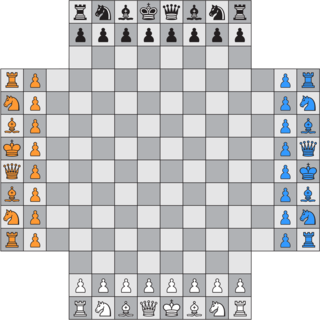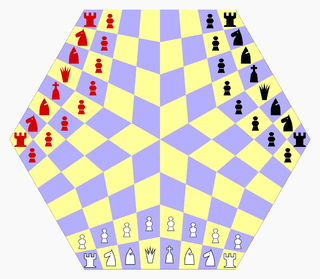
The knight is a piece in the game of chess, represented by a horse's head and neck. It moves two squares vertically and one square horizontally, or two squares horizontally and one square vertically, jumping over other pieces. Each player starts the game with two knights on the b- and g-files, each located between a rook and a bishop.
A fairy chess piece, variant chess piece, unorthodox chess piece, or heterodox chess piece is a chess piece not used in conventional chess but incorporated into certain chess variants and some chess problems. Compared to conventional pieces, fairy pieces vary mostly in the way they move, but they may also follow special rules for capturing, promotions, etc. Because of the distributed and uncoordinated nature of unorthodox chess development, the same piece can have different names, and different pieces can have the same name in various contexts. Most are symbolised as inverted or rotated icons of the standard pieces in diagrams, and the meanings of these "wildcards" must be defined in each context separately. Pieces invented for use in chess variants rather than problems sometimes instead have special icons designed for them, but with some exceptions, many of these are not used beyond the individual games for which they were invented.
Janus Chess is a chess variant invented in 1978 by Werner Schöndorf from Bildstock, Germany. It is played on a 10×8 board and features a fairy chess piece, the janus, with the combined moves of a bishop and a knight. The janus piece is named after the Roman god Janus because this god was usually depicted with two faces looking in opposite directions.
Extinction chess is a chess variant invented by R. Wayne Schmittberger, editor of Games magazine, in 1985. Instead of checkmate as the winning condition, the object of the game is the elimination of all of a particular type of piece of the opponent. In other words, the objective is any of the following:

Four-player chess is a family of chess variants played with four people. The game features a special board typically made of a standard 8×8 square, with 3 rows of 8 cells each extending from each side, and requires two sets of differently colored pieces. The rules are similar to, but not the same as, regular chess. There are a variety of different rule variations; most variations, however, share a somewhat similar board and piece setup.

Hexagonal chess is a group of chess variants played on boards composed of hexagon cells. The best known is Gliński's variant, played on a symmetric 91-cell hexagonal board.
Chess with different armies is a chess variant invented by Ralph Betza in 1979. Two sides use different sets of fairy pieces. There are several armies of equal strength to choose from, including the standard FIDE army. In all armies, kings and pawns are the same as in FIDE chess, but the four other pieces are different.
Three-player chess is a family of chess variants specially designed for three players. Many variations of three-player chess have been devised. They usually use a non-standard board, for example, a hexagonal or three-sided board that connects the center cells in a special way. The three armies are differentiated usually by color.

Senterej, also known as Ethiopian chess, is a regional chess variant, the form of chess traditionally played in Ethiopia and Eritrea. It was the last popular survival of shatranj. According to Richard Pankhurst, the game became extinct sometime after the Italian invasion of Ethiopia in the 1930s. A distinctive feature of Senterej is the opening phase – players make as many moves as they like without regard for how many moves the opponent has made; this continues until the first capture is made. Memorization of opening lines is therefore not a feature of the game.

The following outline is provided as an overview of and topical guide to chess:

Dragonfly is a chess variant invented by Christian Freeling in 1983. There are no queens, and a captured bishop, knight, or rook becomes the property of the capturer, who may play it as their own on a turn to any open square. The board is 7×7 squares, or alternatively a 61-cell hexagon with two additional pawns per side.

The amazon, also known as the queen+knight compound or the dragon, is a fairy chess piece that can move like a queen or a knight. It may thus be considered the sum of all orthodox chess pieces other than the king and the pawn. The amazon can force checkmate on an enemy king without the help of any other friendly piece.

Three-man chess is a chess variant for three players invented by George R. Dekle Sr. in 1984. The game is played on a hexagonal board comprising 96 quadrilateral cells. Each player controls a standard army of chess pieces.

Quatrochess is a chess variant for four players invented by George R. Dekle Sr. in 1986. It is played on a square 14×14 board that excludes the four central squares. Each player controls a standard set of sixteen chess pieces, and additionally nine fairy pieces. The game can be played in partnership or all-versus-all.

Beirut chess is a chess variant invented by Jim Winslow in 1992. The game is played using the standard chess pieces and board, with each side having secretly equipped one of their men with a "bomb"—which can be "detonated" at any time, wiping out all men on surrounding squares along with the bomb carrier.

Game of the Three Kingdoms is a three-player variant of the game xiangqi. The game symbolizes the Three Kingdoms period war (221–264) between the rival states Wei, Shu, and Wu, each vying for control of China after the fall of the Han dynasty.
Portal chess is a chess variant which uses at least two fairy pieces called portals. These pieces can be easily added by using poker chips, coins or other suitably sized objects. The game seeks to incorporate portals to allow pieces to teleport around the board. Apart from the portals and their ruleset, the game often plays like ordinary chess, including the en passant capture, castling, and promotion.
The camel or long knight is a fairy chess piece with an elongated knight move. It can jump three squares horizontally and one square vertically or three squares vertically and one square horizontally, regardless of intervening pieces. Therefore, it is a (1,3)-leaper.
Dynamo chess is a chess variant invented by chess problemists Hans Klüver and Peter Kahl in 1968. The invention was inspired by the closely related variant push chess, invented by Fred Galvin in 1967. The pieces, board, and starting position of Dynamo chess are the same as in orthodox chess, but captures are eliminated and enemy pieces are instead "pushed" or "pulled" off the board. On any given move, a player can make a standard move as in orthodox chess, or execute a "push move" or a "pull move". A move that is either a push move or a pull move is called a "dynamo move".










